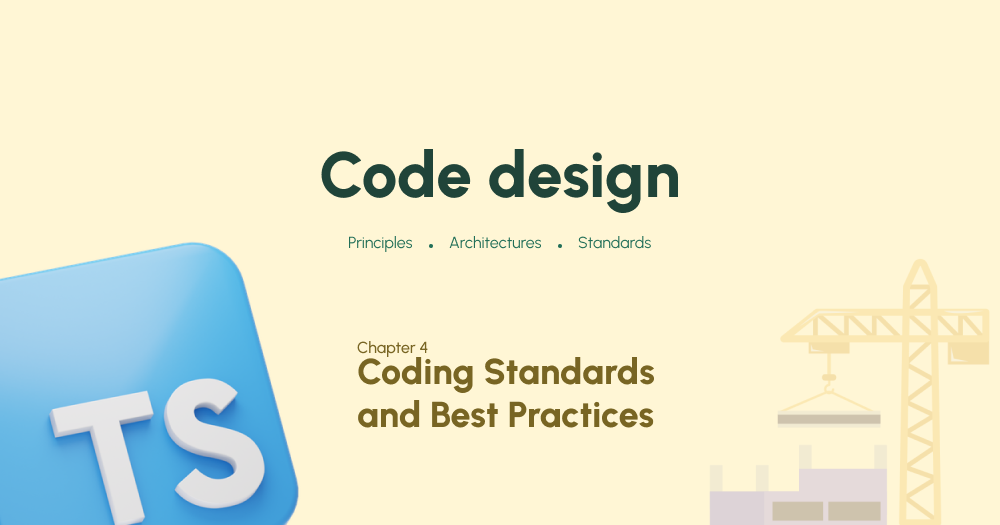Code Design: Chapter 4 - Coding Standards and Best Practices
 Mehdi Jai
Mehdi Jai
Introduction
Coding standards and best practices are crucial for ensuring code quality, maintainability, and collaboration within development teams. Adhering to these practices not only helps developers write better code but also fosters a culture of shared understanding and continuous improvement.
Clean Code
Emphasizes writing code that is easy to read, understand, and maintain. Clean code reduces the risk of bugs and improves team collaboration.
Key Practices:
Naming Conventions: Use descriptive names for variables, functions, and classes to convey their purpose clearly.
Code Structure: Organize code logically, grouping related functionalities together to enhance clarity.
Formatting: Consistent formatting improves readability. Use indentation, line spacing, and comments effectively.
// Example of clean code with meaningful names and clear structure
class User {
constructor(public id: string, public name: string) {}
getDisplayName(): string {
return `${this.name} (ID: ${this.id})`;
}
}
const user = new User('123', 'Alice');
console.log(user.getDisplayName()); // Output: Alice (ID: 123)
Code Reviews
A collaborative process where peers review each other's code to identify issues, share knowledge, and improve overall code quality.
Benefits:
Catch bugs early in the development process.
Encourage knowledge sharing and team cohesion.
Promote adherence to coding standards and best practices.
Tips for Effective Code Reviews:
Keep reviews focused and manageable; review smaller chunks of code.
Provide constructive feedback with clear examples.
Foster a positive and respectful environment.
Common Pitfalls:
Avoid personal criticism; focus on code improvement.
Don't overload the reviewer with too much code at once.
Refactoring
The systematic process of restructuring existing code without changing its external behavior. Refactoring improves code readability and maintainability over time.
Refactoring Techniques:
Extract Method: Break down large methods into smaller, more manageable ones.
Rename Variable: Change variable names to improve clarity and intent (If you use VS Code, use
rename, it will update the variable in all implementations.).Remove Duplicates: Identify and eliminate duplicated code to reduce maintenance efforts.
Clean Code & principles: Follow the Clean Code and Design Principles for scalable, maintainable and readable code.
Documentation: Document your process and change-log. This will help the team members and future developers understand the history of the code and the logic flow.
// Before refactoring: Long function with duplicated code
function calculateArea(length: number, width: number): number {
const area = length * width;
console.log(`Area: ${area}`);
return area;
}
// After refactoring: Extracted method for calculating area
function logArea(area: number): void {
console.log(`Area: ${area}`);
}
function calculateArea(length: number, width: number): number {
const area = length * width;
logArea(area); // Reuse extracted method
return area;
}
calculateArea(5, 10); // Output: Area: 50
Summary
Coding standards and best practices are fundamental to building high-quality software. Clean code promotes readability and maintainability, while code reviews enhance collaboration and improve overall code quality. Refactoring ensures that code remains relevant and efficient over time. Together, these practices help create a productive development environment that fosters continuous learning and improvement, ultimately leading to better software products.
Conclusion
In the dynamic world of software development, the importance of design principles, methodologies, architectural patterns, and coding standards cannot be overstated. By leveraging frameworks like SOLID, TDD, and Microservices, teams can build scalable and maintainable systems that adapt to changing business needs. Clean coding practices and effective collaboration through code reviews further enhance code quality and team cohesion.
As we explore these concepts, stay tuned for upcoming real-world examples that will illustrate how these principles come to life in practical scenarios. Get ready to see how these best practices can transform your development process and lead to exceptional software solutions!
Series Chapters
Subscribe to my newsletter
Read articles from Mehdi Jai directly inside your inbox. Subscribe to the newsletter, and don't miss out.
Written by

Mehdi Jai
Mehdi Jai
Result-oriented Lead Full-Stack Web Developer & UI/UX designer with 5+ years of experience in designing, developing and deploying web applications.